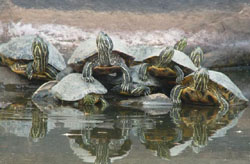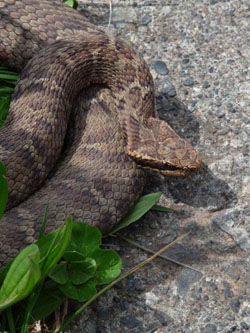Heads up: A clutch (What is the collective noun?) of the widespread but alien Red-eared Slider turtles, seen here at Matsue Castle moat in Shimane Prefecture. | © IMAGES OF JAPAN
'Spotted snakes, with double tongue'
By Mark Brazil | Jun 21, 2009
In ages past we humans relied on natural phenomena and omens from nature to guide us in our understanding of seasonal events and our attempts to make predictions about the uncertain future.There can have been few greater mysteries affecting us then than the vagaries of the weather we depended on for our agriculture. Consequently, the appearance or reappearance of insects, birds and animals as disparate as Ground Hogs and Yellow Wagtails have been used to predict the kind of season to expect ahead, or when it is appropriate to plant or harvest a crop.
If I were dependent on my own limited observations to presage the summer ahead, I could stick my neck out, somewhat slowly in the manner of a soft-shelled turtle, and say that — based on the numbers of reptiles I have seen so far this year — it should be a long and hot summer.
On a number of journeys I have made in the last month, I have bumped into various snakes, turtles and lizards, ranging from the benign to the venomous. Of course, I could also turn naysayer and predict a long and wet summer based on the number of amphibians, most particularly frogs and toads, that I have seen and heard this year from as early as late January in Kyushu (see my April Wild Watch).
I have a colleague who, when confronted with a snake, is swift to move in on it, not just for a closer look, but to catch it and inspect it in the hand. I am not so bold, though I am no ophidiophobe either, and find snakes both fascinating and compelling to observe. However, I share a common and widespread concern about snakes, and when actually confronted with one I invariably strive for a closer view — but always from a safe distance!
Hailing from the perennially damp Midlands of Shakespeare’s “Sceptered Isle,” and despite innumerable nature rambles as a boy, I rarely encountered a scaly-skinned creature back home. Then, at my high school, rather than acquiring much first-hand experience of the living creatures themselves, I became more familiar with Shakespeare’s allusions to serpents, as in: “You spotted snakes, with double tongue, Thorny hedgehogs, be not seen; Newts and blind-worms do no wrong; Come not near our fairy queen’‘
(“A Midsummer-Night’s Dream”)
There was one notable exception, though. Two boyhood chums, Terry Walsh and David North, and I were frequently to be found scouring local woods and reservoirs in our native Worcestershire for birds. But one warm day, nearly 40 years ago now, found us wandering the Malvern Hills in search of a rare (alas, now absent) breeding bird known as the Cirl Bunting.
Our quest for the bird was curtailed by an unexpected find and event. There on a sunny, grassy bank was a tempting target to our young teenaged minds — a curled snake.
Then as now, Britain, it should be stated, is no snake haven. There are, after all, a mere three species, and by then all three of us were vaguely familiar with one of them — the innocuous Grass Snake. Each of us had seen it a sufficient number of times on our various wanderings by bicycle through our home county to enter factoids to the brief debate over the identity of the creature minding its own business in the grass before us.
We should have minded our own business, but having quickly decided between us that we were indeed facing nothing more than a non-venomous Grass Snake, we each reached out to grab it (I was bolder then, but still furthest from it). As if indignant at our misidentification, the Adder (in scientific parlance Vipera berus), for that is what it actually was, uncurled and struck fast toward the nearest symbol of our insulting inaccuracy — an outstretched hand.
That it was Terry’s hand, not David’s or mine that became its target, was a pure fluke of location and timing. Nevertheless, for one brief moment there was our erstwhile Grass Snake attached to Terry’s forefinger by its fangs. A moment later it was gone.
That was when the pain for Terry began and his journey to being photographed for a medical journal commenced. I don’t recall the details of how we took him to hospital, but I remember visiting him there later. The bite produced an enormous, turgid blister, the size of a table-tennis ball, on his finger. His arm, lying atop the covers, was twice its normal size and the swelling continued not only to his shoulder, but down from there to his hip.
Terry’s recovery took time, but was complete. Not so another unfortunate male who died aged 51, of an Adder bite coincidentally also in the Malvern Hills. That case was back in 1932, and that victim became one of only 14 people to die of such bites (according to H. Alistair Reid, writing in the British Medical Journal of July 17, 1976) in the 100 years up to 1975.
Lest this tale be in danger of fueling your fear of snakes, and to give you some context, do bear in mind that in England and Wales from 1950-72, there was only one death from Adder bite, but 61 deaths from bee or wasp stings — and I know not how many more from car accidents.
The humid tropical heat of southern Japan is a far cry from the dampness of England, and in contrast — with its 47 species of snakes alone — Japan is a relative paradise for reptiles.
My first snake encounter of the year, on May 3, was, surprisingly, not with a Japanese Rat Snake (Aodaisho), the species I most frequently encounter here in cool Hokkaido, but with an Adder lookalike — a Japanese Mamushi (Gloydius blomhoffii).
Basking in sunshine is a favorite activity of many species of snakes, but for some reason members of the family Viperidae particularly enjoy it. They become drowsy in the sun, or perhaps it’s because they have become cool and then sluggish that they move into the sun to warm themselves and become active. Either way, exposed banks and roadsides are ideal places to find them, whether the Habu and Himehabu snakes of the Ryukyu Islands or the Mamushi, which ranges from Yakushima Prefecture north to Hokkaido.
The particular Japanese Mamushi I encountered incited in me much the response that I had had to that Adder in the Malvern Hills as a teenager, though I was more cautious. It struck repeatedly, but sluggishly and away from me. In doing so, however, it revealed its extraordinarily distinctive body shape — broadly elongate, but with a very short and rapidly tapering tail.
This is a great time of year to seek out warmth-loving reptiles, and the further south you are in Japan the more species you have to look for, with Okinawa being best blessed. Visit local ponds to look for turtles; there are a number of native species — and the now widespread, introduced Red-eared Slider — to be found at temple ponds, lakes and river backwaters; watch for the rapid movements of skinks and lizards along walls, in sunlit dry grasses and at woodland edges; and see if you can spot snakes as they appear in woodlands, fields and at roadsides.
And if you see any interesting species, do please send me a photograph.


